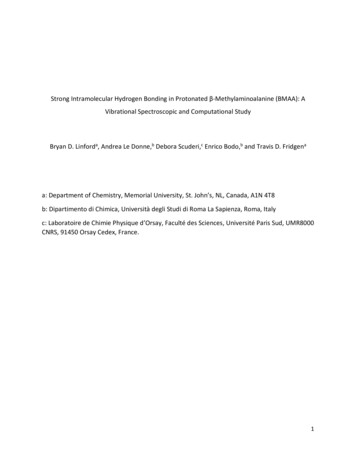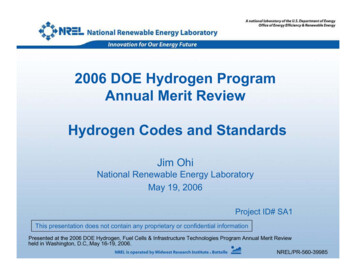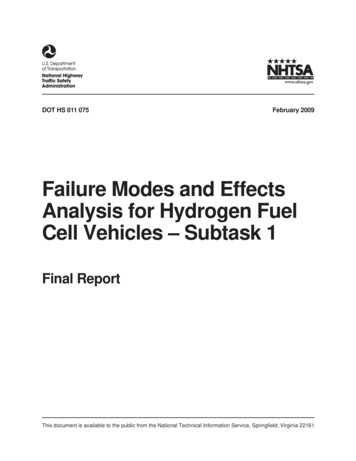
Transcription
Strong Intramolecular Hydrogen Bonding in Protonated β‐Methylaminoalanine (BMAA): AVibrational Spectroscopic and Computational StudyBryan D. Linforda, Andrea Le Donne,b Debora Scuderi,c Enrico Bodo,b and Travis D. Fridgenaa: Department of Chemistry, Memorial University, St. John’s, NL, Canada, A1N 4T8b: Dipartimento di Chimica, Università degli Studi di Roma La Sapienza, Roma, Italyc: Laboratoire de Chimie Physique d’Orsay, Faculté des Sciences, Université Paris Sud, UMR8000CNRS, 91450 Orsay Cedex, France.1
AbstractThe gas‐phase structure of protonated β‐methylaminoalanine was investigated using infraredmultiple photon dissociation spectroscopy in the C‐H, N‐H, O‐H stretching region (2700‐3800cm‐1) and the fingerprint region (1000‐1900 cm‐1). Calculations using DFT methods show thatthe lowest energy structures prefer protonation on the secondary amine. Formation ofhydrogen bonds between the primary and secondary amine, and the secondary amine andcarboxylic oxygen further stabilize the lowest energy structure. The IR spectrum of the lowestenergy structure originating with harmonic DFT has features that generally match the positionsof the experimental spectra, however the overall agreement with the experimental spectrum ispoor. Molecular dynamics calculations were used to generate a gas‐phase IR spectrum. Withthese calculations a reasonable match with the experimental spectrum, especially in the highenergy region, was obtained. The results of the molecular dynamics (MD) simulation supportthe DFT calculations, with protonation on the secondary amine and the formation of ahydrogen bond between the protonated secondary amine and the primary amine. This workshows the importance of accounting for anharmonic effects in systems with very strongintramolecular hydrogen bonding.2
1. Introduction.β‐methylaminoalanine (BMAA, Scheme 1) is a naturally occurring, non‐proteinogenic aminoacid and has been speculated to be a contributing factor in amyotrophic lateral sclerosis (ALS),Parkinson's disease (PD), and other related forms of neurological diseases.1–5 BMAA has beenthe topic of much research, as some studies show it may be produced by cyanobacteria. Theseorganisms are ubiquitous in most environments and have the potential to cause harm tohuman populations.6–11 BMAA is also thought to bioaccumulate and may be found in animals orfish commonly eaten by humans. 3,4,12,13While many early studies on BMAA have found it in a wide variety of environments andtissue samples, including human nervous tissue, research has also shown that BMAA detectionis complicated by several factors, most notably separation of BMAA from its isomers andcomplications due to the sample matrix.11,14–19 This may result in false positives, leading to thethought that BMAA is more relevant in neurological disorders than it actually is. In marineenvironments, BMAA was also found to be produced by diatoms, and can be found commonlyin shellfish that feed on these diatoms.14,20–22 Conflicting analytical data likely arises due tomethodology, and a lack of understanding of the physical properties of BMAA. While progresshas been made on better methods for BMAA analysis, there has been little work done on itsbasic structure or energetics. Some work on eliminating matrix effects in BMAA detection, suchas clean up methods using solid‐phase extraction, and differential mobility spectrometry forisotope separation has been conducted.14,15 The effects of metal ions, such as sodium or zinc, inthe sample matrix have also been examined, though this work did not fully examine the gas‐phase structures or chemistry of the observed complexes.23 These studies show that there canbe problems with detection of BMAA due to the interreference of other isotopes or metals inthe sample matrix which have not been fully explored.Mass spectrometric techniques are widely used to elucidate the gas‐phase structuresand energetics of many different systems and have been very successful in biologically relevantsystems. Spectroscopy can also be coupled with ion trap mass spectrometers for structuralanalysis by generating a vibrational spectrum using a tuneable infrared laser. The hydrogen3
bonding environment of the molecule is of interest, as these interactions are important forrelatively strong bonding in biological systems.24–28 Additional use of computational techniqueshas been used to find possible structures of systems with proton bonding, as well as theirenergetics. While normal harmonic approximation methods usually work for infrared spectracomparison, problems can arise in systems that have strong anharmonic interactions, such as inthe case of a strong hydrogen bond. These can be better represented by using moleculardynamics calculations which have been shown to give accurate representation of such stronglyproton‐bound systems.29–32 In this work protonated BMAA complexes are studied in the gasphase by infrared multiple photon dissociation (IRMPD) spectroscopy in both 2700‐3800 cm‐1and 1000‐1900 cm‐1 regions, SORI‐CID, and computational methods. Comparison of the IRMPDspectra with calculated IR spectra are used to identify the most likely structures.2. Methods.2.1. Experimental. Experiments were performed on two different Bruker Apex Qe7 FTICR massspectrometers, one in the Laboratory for the Study of the Energetics, Structures, and Reactionsof Gaseous Ions at Memorial University of Newfoundland (MUN) and one at the Centre LaserInfrarouge d’Orsay (CLIO), in France. Ions were generated by electrospray ionization of a diluteaqueous BMAA solution in a 50/50 methanol/water (18 MΩ cm Millipore) solvent preparedusing 100µL of 10mM BMAA diluted to 1mL. The spray capillary was 150 oC and desolvated ionswere transferred to the hexapole where they were accumulated for 2 s prior to beingtransferred and isolated in the FTICR. Low energy sustained off resonance irradiation collisioninduced dissociation (SORI‐CID) under the presence of argon gas ( 10‐6 mbar) is used toelucidate the unimolecular chemistry of these ions.Structural information is obtained from IRMPD spectroscopy in the 2700‐3800 cm‐1range using an optical parametric oscillator (OPO) laser (LaserSpec, 500 mW) at MUN, whichcan be tuned from 1.4 to 4.5 µm over 2 cm‐1 intervals with an irradiation time of 2 seconds. Inthe 1000‐1900 cm‐1 range, spectra are acquired using the CLIO free electron laser (FEL),scanned at 5 cm‐1 intervals with 1 second irradiation times. The CLIO FEL laser power was on4
average 1 W over the fingerprint region. The experimental spectra were obtained by plottingthe IRMPD efficiency vs the laser radiation wavenumber. The IRMPD efficiency is defined as I IRMPD Efficiency log precursor I total Where I precursor is the mass spectral intensity of the precursor ion and I total is the sum of theparent and fragment ion intensities.2.2. Computational Methods. Computational work was done using the Gaussian 09 package.33Structures were optimised and their infrared spectra were computed using density functionaltheory (DFT) with the B3LYP functional and 6‐311 G(d,p) basis set. 298 K enthalpies and Gibbsenergies, relative to the lowest energy structure found, are derived from the electronicenergies as well as unscaled thermal components from the frequency calculations. Computedharmonic frequencies were scaled by 0.955 and 0.975 in the 2700‐3800 cm‐1 and 1000‐1900cm‐1 regions, respectively, to improve the harmonic approximation prediction of the vibrationalspectrum and generate a better match with experimental results. Spectra were convoluted witha Lorentzian profile with full width at half max of 10 cm‐1.2.3. Molecular Dynamics. Car‐Parrinello Molecular Dynamics34 simulations were performedusing the BLYP functional with library Trullier‐Martin pseudopotentials35. A cell with 18.0 Å2 wasused along with the typical options for an isolated molecule, in particular, the Poisson equationsolver for an isolated system was enforced using the method by Tuckermann36. The MDtrajectory was divided into two parts: the first part was obtained in NVT conditions (constantnumber, volume, and temperature), using a Berendsen thermostat at 300 K and waspropagated for 16 ps with 2.0 a.u. timestep (1 a.u. 0.0242 fs). The second part was performedin the NVE ensemble (constant number, volume, and energy), for total simulation time of 12 pswith 3.0 a.u. timesteps. The dipole of the molecule during both portions of the dynamics hasbeen calculated using the Wannier centers and the positive charges of the ions. The dipole as afunction of time was auto‐correlated and the result was Fourier‐transformed to obtain the IRspectrum. In the following, the IR spectrum as obtained from the NVE portion of the trajectoryis presented. In order to account for the well‐known effect due to the massive Car‐Parrinello5
electrons the theoretical spectra have been blue‐shifted by 90 cm‐1.37 The plane‐waves cutoffwas 110 atomic units in the CPMD simulations.We have propagated the dynamics of three different initial structures: a minimumstructure corresponding to the protonated primary amine, a minimum structure correspondingto the protonated secondary amine, and a third conformer that was chosen to represent astructure without N‐H‐‐N hydrogen bonding.3. Results and discussion.3.1. Experimental Results. The only observed fragmentation pathway from SORI‐CID for[H(BMAA)] , m/z 119, is the loss of 17 Da (NH3) producing an ion at m/z 102 (Figure 1). Whenirradiated with the OPO laser, the loss of NH3 was also observed. Depending on the frequencyof the laser, a secondary loss of 18 Da (H2O) forming m/z 84 was also observed. The m/z 84 ionis formed during IRMPD activation with 3560 cm‐1, O‐H stretching, since the fragment at m/z102 also absorbs at this frequency; it is not observed during IRMPD activation with 3420 cm‐1because this is the NH2 antisymmetric stretch of the primary amine and m/z 102 has lost thisfunctionality. The m/z 84 ion is also not observed during SORI‐CID since only m/z 119 isactivated in the process and the m/z 102 fragment is formed without enough energy toundergo further dissociation. The loss of NH3 from [H(BMAA)] is consistent with observationsfor low‐energy collision induced dissociation performed by other groups.14,15 The other lowintensity signals in the mass spectra between 70 and 110 are artifacts and are always present.The experimental IRMPD spectra of [H(BMAA)] in the 2700‐3700 cm‐1 region and the1000‐1900 cm‐1 region are shown in Figure 2, the top traces. A strong O‐H stretch is observedaround 3560 cm‐1 while resolved N‐H antisymmetric stretching is observed at around 3430 cm‐1 38. There is also a very broad absorption spanning the 3360‐3000 cm‐1 region indicating strongintramolecular hydrogen bonding.39 The IRMPD spectrum in the 1000‐1900 cm‐1 range showsweak bands at 1755 and 1412 cm‐1, as well as a strong band at 1150 cm‐1.3.2. Calculated structures of [H(BMAA)] . Figure 3 shows the six lowest energy structuresfound for [H(BMAA)] . Of the twelve unique structures obtained from our calculations (see alsoFigure S1), the four lowest energy structures are within 13 kJ mol‐1 of Gibbs energy. All but five6
of the twelve structures are protonated at the secondary amine, including the four lowestenergy structures. In the lowest energy structure (I), both hydrogens on the protonatedsecondary amine are taking part in intramolecular hydrogen bonds; one with the primaryamine, and one with the carbonyl of the carboxylic acid group. In the second lowest energystructure (II), the carboxylic acid group has been rotated so that instead of hydrogen bondingwith the secondary amine it is hydrogen bonding with the primary amine. This change results ina structure that is 11.8 kJ mol‐1 higher in energy (10.4 kJ mol‐1 higher in Gibbs energy) than theprevious structure. Structure III is computed to be only 1.0 kJ mol‐1 higher in energy (0.4 kJ mol‐1 in Gibbs energy) than II and only differs by a change in the NCCN dihedral angle simplyresulting in a change in the secondary N‐H that is the hydrogen bond donor to the primaryamine. Structure IV is related to structure III, with the carboxylic acid group rotated resulting inan interaction between the hydroxyl oxygen and a primary amine hydrogen and is higher inenergy by 4.0 kJ mol‐1 than III (2.1 kJ mol‐1 in Gibbs energy).Structures where protonation is on the primary amine (VI, VII, VIII, IX, and XII) are alsosignificantly higher in energy (Figure 3 and Figure S1), between 26.3 and 38.7 kJ mol‐1.Structures where there is no hydrogen bond between the secondary amine as the hydrogenbond donor and primary amine as the acceptor (V, X, and XI) are between 20 and almost 60 kJmol‐1 higher in energy than I and can be seen in Figures 3 and S1.3.3. Comparison of experimental IRMPD spectra with the DFT‐computed IR spectra.The calculated IR spectra (harmonic approximation) for the four lowest energystructures of [H(BMAA)] are compared with the experimental IRMPD spectrum in Figure 2. Inthe 2700‐3700 cm‐1 region, a free O‐H stretch is predicted for all four structures at about 3560cm‐1 which matches the experimental feature at 3560 cm‐1. The O‐H stretch is slightly higher inenergy for structures II‐IV, as the hydrogen bond with the primary amine is expected to beslightly weaker compared to the secondary amine hydrogen bond observed in the lowestenergy structure such that the O‐H bond is slightly weaker for structure I. The band computedat 3415 cm‐1 in the calculated spectra all correspond to the antisymmetric NH2 stretch of theprimary amine, which can be associated with the 3425 cm‐1 feature in the experimental7
spectrum. In the lowest energy structure there is a band predicted at 3335 cm‐1 due to thesymmetric NH2 stretch of the primary amine. This absorption is predicted in all of the lowestenergy structures and the intensity maximum of the very broad feature at 3340 cm‐1corresponds well with the computed position.
energy structures. In the lowest energy structure (I), both hydrogens on the protonated secondary amine are taking part in intramolecular hydrogen bonds; one with the primary amine, and one with the carbonyl of the carboxylic acid group. In the second lowest energy











